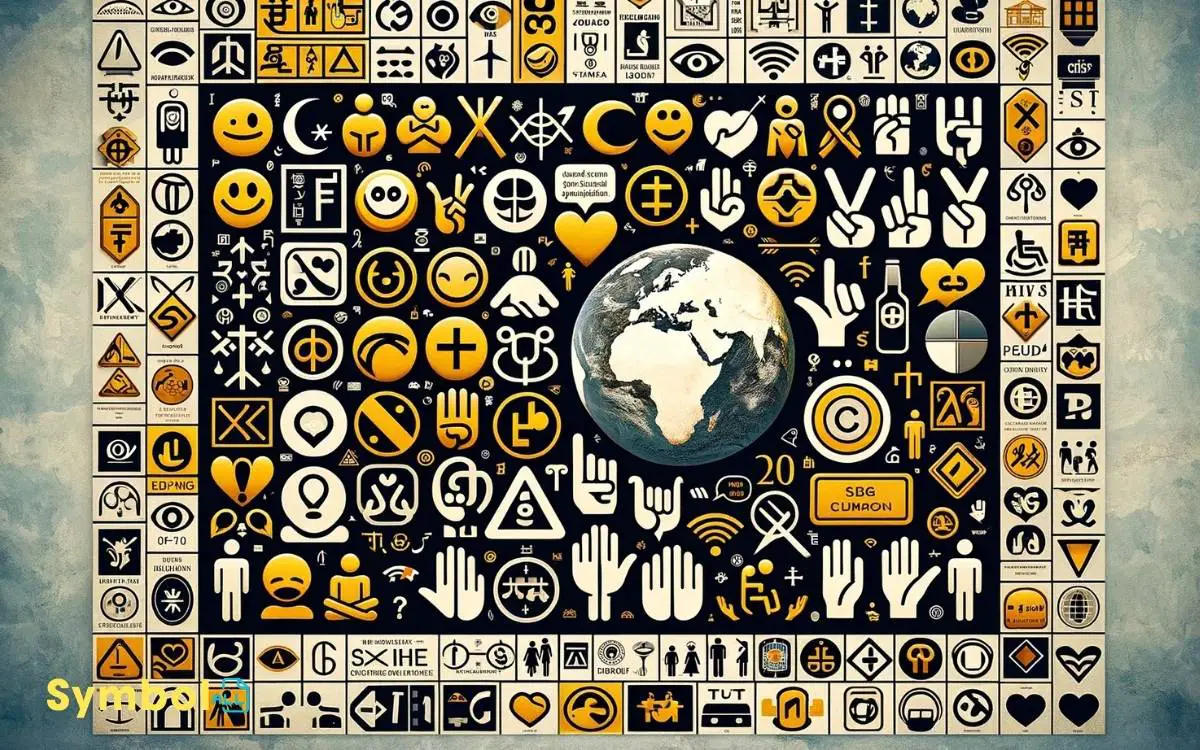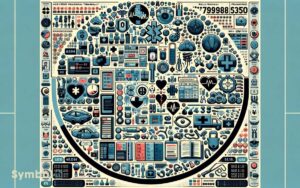What Are Some Symbols People Use to Communicate? Explains!
Symbols are your silent emissaries in the global conversation. From ancient cave paintings to modern digital icons, they’ve evolved to convey complex ideas across cultures.
Traffic signs, with their color-coded lights and distinct shapes, command and guide your daily commute. Body language, like a nod or crossed arms, reveals your emotions and attitudes without a word.
Religious and spiritual symbols, embodying deep beliefs, connect you to the mystical. Even financial literacy hinges on understanding currency and economic symbols.
Each symbol, from national flags to corporate logos, encapsulates a wealth of meaning, bridging gaps in language and comprehension. Embarking on this journey offers a richer understanding of the world’s communicative tapestry.

Key Takeaways
Historical Roots of Symbols
Symbols, as tools for communication, have evolved from ancient cave paintings and hieroglyphs, reflecting humanity’s enduring quest to document and share knowledge.
This progression showcases not just a shift in mediums but an intricate development in the complexity and abstraction of the ideas conveyed.
You’ll notice that early symbols often depicted literal interpretations of the physical world, serving as direct representations of objects or concepts familiar to their creators.
As societies advanced, so did their symbolic language, incorporating more abstract figures to denote complex concepts such as religious beliefs, cultural values, and social norms.
This historical evolution underscores the inherent human need to create and understand symbols, a testament to their vital role in fostering connections and facilitating communication across different cultures and eras.
Traffic Signs and Signals
Within the realm of modern society, traffic signs and signals stand as critical tools for managing the flow of vehicles and pedestrians, ensuring safety and efficiency on our roads.
These symbols serve as a universal language, transcending linguistic barriers to deliver clear, immediate messages.
- Stop Signs: Command drivers to halt completely before proceeding.
- Traffic Lights: Regulate vehicle and pedestrian movement through color-coded signals.
- Yield Signs: Indicate drivers must give right of way to others.
- Speed Limit Signs: Inform drivers of maximum allowable speeds.
- Pedestrian Crossing Signs: Alert drivers to areas where pedestrians may cross.
Each element is designed with specific colors, shapes, and symbols to convey its message effectively, demonstrating the intricate relationship between visual communication and societal function.
Body Language and Gestures
You must recognize that your understanding of common gestures significantly impacts your ability to communicate across cultural contexts.
Variations in gestures from one culture to another can lead to misunderstandings if you’re not well-informed.
Therefore, it’s crucial to analyze these cultural differences in gestures to enhance effective communication.
Understanding Common Gestures
Interpreting common gestures, an integral aspect of non-verbal communication, requires an understanding of the nuanced ways body language conveys meaning and intent.
Here are key gestures to be aware of:
- Nodding: Often indicates agreement, understanding, or approval.
- Crossed Arms: Can signify defensiveness, self-protection, or discomfort.
- Eye Contact: Maintaining eye contact demonstrates confidence and interest, whereas avoiding it may suggest discomfort or evasion.
- Thumbs Up: Universally recognized as a sign of approval or satisfaction.
- Leaning In: Suggests interest and engagement in the conversation or situation.
Analyzing these gestures within a given context enriches your interpretation, enhancing communication effectiveness. Recognizing these non-verbal cues allows for a deeper understanding of others’ thoughts and feelings, fostering more meaningful interactions.
Cultural Variations in Gestures
Exploring the cultural variations in gestures reveals a complex landscape where identical movements can convey drastically different meanings across societies.
You’ll find that a nod, often interpreted as affirmation in many Western cultures, can signify disagreement or refusal in parts of South Asia.
Similarly, the thumbs-up gesture, considered a sign of approval in the U.S.A, can be deemed offensive in Middle Eastern countries.
This divergence underscores the importance of context in interpreting body language. It’s not merely about the gesture itself but how, where, and by whom it’s used.
As you navigate these cultural nuances, you become more adept at understanding the unspoken dialogues that pervade global interactions, enhancing your cross-cultural communication skills and fostering a deeper respect for the rich tapestry of human expression.
Religious and Spiritual Symbols
You’ll observe that religious and spiritual symbols such as the Cross and the Om carry profound meanings within their respective traditions, Christianity and Hinduism.
The Cross represents the crucifixion and resurrection of Jesus Christ, embodying faith, sacrifice, and salvation.
Conversely, the Om symbol encapsulates the essence of the ultimate reality and the universe in Hindu philosophy, signifying unity and the interconnectedness of all things.
Cross: Christianitys Emblem
As a quintessential symbol of Christianity, the cross embodies both the crucifixion of Jesus Christ and the broader themes of sacrifice and redemption central to the faith. It’s not merely a reminder of Christ’s physical suffering but also a profound representation of spiritual deliverance.
To grasp its significance, consider the following aspects:
- The cross’s intersection signifies the connection between the divine and the earthly.
- Its vertical axis symbolizes the divine, reaching towards heaven, while the horizontal axis represents humanity’s spread across the earth.
- The empty cross, often seen in Protestant Christianity, emphasizes Jesus’s resurrection and victory over death.
- In contrast, the crucifix, prominent in Catholic and Orthodox Christianity, depicts Jesus on the cross, highlighting his sacrifice for mankind’s sins.
- The cross serves as a universal symbol of hope, faith, and unconditional love within the Christian community.
Om Symbol: Hinduisms Essence
The Om symbol, an ancient Sanskrit character, encapsulates the essence of Hinduism by representing the universe’s fundamental spiritual sound.
You’ll find it integral not only in religious scriptures, practices, and ceremonies but also deeply embedded in the daily life and spiritual ethos of millions.
This symbol, consisting of three curves, a semi-circle, and a dot, intricately represents the waking, dream, and unconscious states of the human experience, with the dot signifying the fourth state of consciousness, pure silence.
Its graphical structure and phonetic resonance connect the material with the spiritual, reminding you of the cyclical nature of the universe.
The Om symbol’s profound depth serves as a bridge between the tangible and the intangible, offering a pathway to understanding the interconnectedness of all existence.
Mathematical and Scientific Notation
Understanding mathematical and scientific notation is crucial for accurately interpreting and conveying complex ideas and equations in these fields.
These notations serve as a universal language, enabling researchers and scholars from around the globe to share their findings without linguistic barriers.
Here are key components:
- Variables and Constants: Symbols representing quantities that can change or remain constant.
- Operators: Symbols denoting mathematical operations, such as addition (+), subtraction (-), and multiplication (×).
- Functions: Notations like f(x) indicating a relationship between sets of numbers or variables.
- Greek Alphabet: Used to represent constants, variables, and parameters (e.g., α for alpha, β for beta).
- Equational Structures: Formats for writing equations and inequalities, essential for formulating scientific theories and mathematical proofs.
Grasping these elements is essential for anyone delving into mathematical or scientific disciplines, ensuring effective communication and understanding of complex concepts.
Currency and Economic Indicators
Moving beyond mathematical and scientific notation, it’s important to explore symbols in currency and economic indicators, which play a pivotal role in global financial systems and economic analysis.
Currency symbols, such as the dollar sign ($), euro (€), and yen (¥), aren’t just abbreviations of monetary units. They’re shorthand for complex economic concepts, embodying the economic strength and stability of their respective nations.
Similarly, economic indicators like GDP (Gross Domestic Product), CPI (Consumer Price Index), and unemployment rates are distilled into simple figures or symbols, yet they represent exhaustive data about economic health and trends.
Understanding these symbols allows you to grasp the nuances of economic policies, market dynamics, and international trade. Each symbol serves as a gateway to deeper insights into the global economy, necessitating a keen analytical approach to decode their implications.
Corporate Logos and Branding
In the realm of global commerce, corporate logos and branding serve as the quintessential symbols of a company’s identity, values, and market position.
These visual representations are meticulously crafted to communicate a multitude of messages to consumers, investors, and competitors. They’re not just mere symbols; they’re a shorthand for the brand’s narrative.
- Consistency: Ensures a uniform identity across various platforms and mediums.
- Recognition: Aids in immediate identification in a crowded marketplace.
- Emotional Connection: Evokes feelings, creating a personal tie with the consumer.
- Differentiation: Sets the brand apart from competitors, highlighting unique selling propositions.
- Loyalty and Trust: Fosters a sense of reliability and familiarity, encouraging repeat business.
Understanding these elements allows you to grasp the profound impact logos and branding have in shaping consumer perceptions and behaviors.
National Flags and Emblems
Just as corporate logos and branding solidify a company’s market presence, national flags and emblems play a pivotal role in uniting people under a common identity and heritage.
These symbols encapsulate a nation’s history, values, and aspirations, serving as a visual shorthand for its culture and political ideals.
They’re not merely designs; they’re a distillation of a country’s essence, crafted to inspire pride and a sense of belonging among its citizens.
| Country | Symbol Type |
|---|---|
| United States | Stars and Stripes |
| Canada | Maple Leaf |
| Japan | Red Sun Disc |
| United Kingdom | Union Jack |
| Brazil | Green and Yellow Rhombus |
Each emblem’s design elements are rich in meaning, meticulously chosen to reflect the nation’s soul and communicate its unique story to the world.
Digital Icons and Emojis
You observe that the landscape of digital communication undergoes constant transformation, significantly influenced by the evolution of emojis and the fluctuating trends in icon usage.
These symbols serve not merely as tools for enhancing textual conversations but also as pivotal elements in the lexicon of digital expression, reflecting broader cultural shifts and technological advancements.
Analyzing these changes offers insights into how digital communities adapt and shape their modes of interaction, underlining the symbiotic relationship between technological innovation and social communication practices.
Emoji Evolution
Digital icons and emojis have undergone a significant transformation, evolving from simple emoticons created with punctuation marks to complex, colorful images that convey a wide array of emotions and concepts.
This evolution reflects not only technological advancements but also a deeper integration of digital communication into daily life.
Consider the following points:
- Emojis now include a diverse range of human emotions and reactions.
- They offer representation across different cultures and identities.
- Technological updates have introduced animated and 3D emojis.
- Emojis contribute to the creation of a nuanced digital language.
- They adapt and expand to include new societal and environmental symbols.
This transformation underscores the dynamic nature of digital communication, highlighting how emojis have become indispensable in expressing emotions, enhancing messages, and bridging communication gaps in the digital age.
Icon Usage Trends
Emojis and digital icons, reflecting societal trends and cultural shifts, have significantly influenced communication patterns across various platforms. These symbols serve as a concise means to convey emotions, concepts, and reactions, transcending language barriers.
The adoption and usage trends of these icons are not static; they evolve with societal values and technological advancements.
| Trend | Impact |
|---|---|
| Increased Diversity | Promotes inclusivity by representing a wider spectrum of human experiences. |
| Animated Emojis | Enhances expressiveness, adding a dynamic layer to digital conversations. |
| Custom Emojis | Allows personalization, reflecting individual identity and creativity. |
Incorporating these icons into digital communication enriches the exchange, making it more enjoyable and relatable. As you navigate through various digital platforms, understanding these trends helps you appreciate the depth and breadth of modern symbolic communication.
Environmental and Safety Symbols
Environmental and safety symbols serve as critical tools for conveying information about potential hazards and sustainable practices, guiding individuals in making informed decisions to protect both themselves and the environment.
These symbols are meticulously designed for universal comprehension, transcending language barriers and ensuring immediate recognition of risks and protocols.
Consider the following examples:
- Recycling symbols: Indicate the recyclability of materials, promoting sustainable waste management.
- Biohazard signs: Warn of materials that pose biological risks, ensuring safety measures are taken.
- Radiation symbols: Alert to the presence of radioactive materials or areas, preventing unnecessary exposure.
- Energy efficiency labels: Provide insights into the energy consumption of appliances, encouraging eco-friendly choices.
- Fire exit signs: Direct individuals to safety in case of fire, highlighting escape routes.
Understanding these symbols is paramount for fostering a safer, more sustainable world.
Conclusion
In the tapestry of human communication, symbols serve as the threads binding our collective consciousness. From the ancient echoes of hieroglyphs to the digital whisper of emojis, each symbol is a testament to humanity’s quest to transcend the barriers of language. These symbols are not merely tools of representation; they are vessels carrying cultural nuance and historical depth. Languages that use logographic symbols, such as Chinese, exemplify how a single character can embody layers of meaning, blending artistry with communication. In this intricate dance between form and function, symbols continue to evolve, reshaping how we connect in an increasingly globalized world.
They aren’t mere markers but the compasses guiding us through the labyrinth of cultural, scientific, and spiritual landscapes.
As mirrors reflecting societal values and norms, symbols embody the essence of our shared journey, etching the contours of our identity across the canvas of time.






